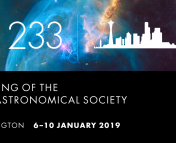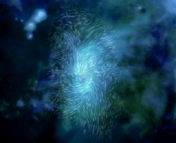Light pollution isn’t just in the visible – commercial interests threaten scientific, amateur radio operations
Disclaimer: “Beyond astro-ph” articles are not necessarily intended to be representative of the views of the entire Astrobites collaboration, nor do they represent the views of the AAS or all astronomers. While AAS supports Astrobites, Astrobites is editorially independent and content that appears on Astrobites is not reviewed or approved by the AAS.
If you live in any reasonably-sized metro area, you’re familiar with light pollution. Even on the darkest nights, you’ll never see more than a handful of stars, and the sky itself glows with the reflections of city lights. Professional astronomy has long left the suburbs for remote observatories, and most urban/suburban residents have never seen the Milky Way splashed across the night sky. The brightest objects you’ll see on a daily basis are the Sun, the Moon, and artificial satellites, the vast majority of which are members of satellite megaconstellations.
A NOIRLab diagram showing degrees of light pollution, ranging from dark sky sites to polluted cities: NOIRLab/NSF/AURA, P. Marenfeld
Like their names imply, satellite megaconstellations are big news. From providing internet connectivity across warzones, to streaking through astronomical images, to littering low-earth orbit with debris, these collections of thousands of satellites are, quite literally, everywhere. Odds are good that there’s at least one satellite flying over your head at this very moment! As our world becomes more thoroughly networked, it appears they’re here to stay.
Astronomers and satellite operators have historically been at loggerheads, highlighting concerns such as light pollution and collision avoidance, but it’s not just the optical observers who’ve got glaring issues. Recent work from researchers at the Square Kilometer Array Observatory have shown that SpaceX’s Starlink satellites leak radio signals outside their intended communications bands, contaminating those used by radio astronomy facilities such as the Green Bank Telescope. These scientific, commercial, and communications bands are allocated by national and international bodies, and aim to regulate radio traffic in a way that minimizes interference. However, unintentional interference (like that from Starlink satellites) can still creep in and jam signals or interfere with astronomical observations.
To SpaceX’s credit, they have been in close contact with the authors, promising to mitigate these issues like they’ve done with the optical reflectivity of Starlink satellites, but work like this highlights the urgency of monitoring protected bands for similar contamination, so that current, flawed satellite designs can be fixed to avoid leaks. Better, of course, would be foresight on the part of satellite designers and manufacturers to ensure proper operations in the first place.
Radio interference isn’t just unintentional, though. The “Shortwave Modernization Coalition”, a group of financial trading firms, is asking the Federal Communications Commission to modify its regulations of shortwave radio frequencies below 25 MHz. Under experimental licenses, they’ve been using shortwave radio transmissions to test their operations. Now, the SMC are asking for permanent changes to the allocated bands, allowing for rapid transactions that are faster and more secure than satellite links or intercontinental fiber-optics. Unfortunately, the bands they are asking to be modified are used by some radio astronomy facilities (such as LOFAR and the LWA), but are even more heavily used for amateur radio communications. This is the reason why the American Radio Relay League, the National Association for Amateur Radio, submitted comments objecting to the proposal. An ARRL study of the proposed changes found that amateur users would be subject to significant destructive interference by the financial broadcasts, and recommended that SMC’s petition be rejected. No FCC decision has yet been reached, so we’ll soon see whether amateur and nonprofit use of these radio bands will continue to be protected.
While the public comment period for this petition is over, this episode (like the Starlink story) should remind us that we can always advocate for effective protections against potentially harmful industrial activity. Whether this is using our professional facilities to monitor the skies for flawed satellites, or speaking up when commercial interest groups want to throw their weight around to boost profits, astronomers and the general public can make a difference.
Featured Image Credit: Frank Ross Productions Ltd./RKO Radio Pictures
Astrobite edited by Lina Kimmig




